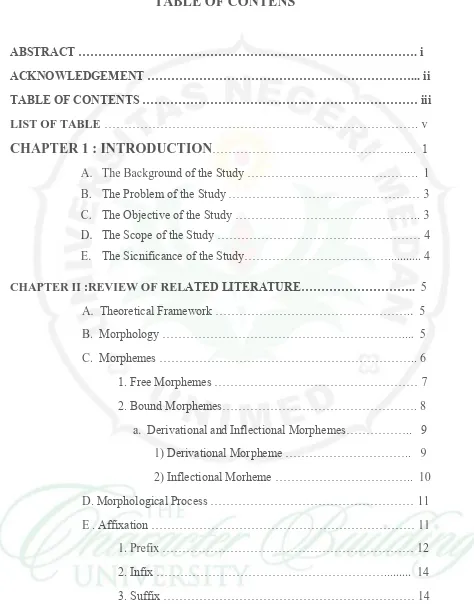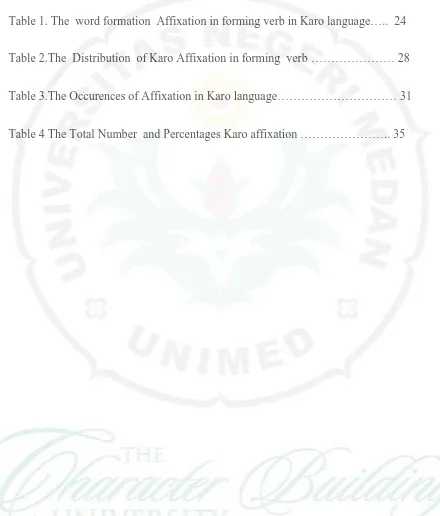A STUDY OF KARONESE AFFIXATION IN FORMING VERB
A THESIS
Submitted in Partial fullfilment of the Requirement for the Degree of Sarjana Sastra
BY
OKTA VIANUS
Reg No 208222049
ENGLISH AND LITERATURE DEPARTMENT
FACULTY OF LANGUAGE AND ARTS
ABSTRACT
Oktavianus. A study of Karonese Affixation in forming verb. A Thesis. English Departement Faculty of Language and Arts. State University of Medan 2012. This study deals with affixation of Karo Language in forming verb. The
objectives of this study are to describe the morphological process of affixation in forming verb in Karo language as well as to describe the function and the
grammatical meanings of affixation in forming verb in Karo language. The method of research is library research by reading some books related to this study. The
instruments of collection data used tape recorder. The technique of analysis data is documentary technique namely identifying the data, classifying the data and finding the dominant type of affixation in Karo language. The findings showed that there are four kinds of Karonese affixation in forming verb namely: (1). Prefix occurs 51 (48%). (2). Infixes occurs 3 (2%), (3). Suffixes occurs 43 (30%) and (4). Confixes occurs 18 (10%) and the total occorences is 119. So the dominant type of affixation found in Karonese in forming verb is Prefix occurs 51(48%). The function of affixation in Karo language are derivational and inflectional, derivational is change the meaning after attached by affix to the stem for example: {er-} + lajang →
/erlajang/, /lajang/ means „alone‟, prefix {er-} is inserted, it becomes /erlajang/ means „going‟ and inflectional is does not change the meanings after attached by affix to the stem for example: ayak + {-i} → /ayaki/ , /ayak/ means „running‟, suffix {-i}
ii
ACKNOWLEDGEMENT
First of all I would like to thank God for the blessing and the strength given to the writer during completion of this thesis. This thesis amied at fulfiling one of the requirements for the degree of Sarjana Sastra at English Departement, Faculty of Language and Arts (FBS) State University of Medan (UNIMED).
In Completing this thesis, the writer would like to express his gratitude to the followings people :
Prof. Dr.H.Ibnu Hajar Damanik, M.Si., as the Rector of State University of Medan.
Dr. Isda Pramuniati,M.Hum., the Dean of Faculty of Languags and Arts (FBS) State University of Medan for Her attention and encouragement to complete this thesis on time.
Prof. Dr.Hj.Sumarsih, M.Pd. and Dra. Rahmah, M.Hum., both as the Head and the Secretary of English and Literature FBS Unimed, Dra. Meisuri, M.A., the Head of Literature study program for all suggestions and administrative and advice that given to the writer in his academic years at the English and Literature Departement.
Dr. Zainnuddin,.DIP.TEFL.,M.Hum., his thesis consultant for his invaluable advices, giving comments, making some corrections as well as giving encouragement to the writer during the process of writing this thesis.
For all Lecturers of English and Literature Departement FBS UNIMED for giving invaluable information and science, especially English Literature. His beloved parents M. Perangin- angin and K. Brahmana for giving
encouragement that never ending.
His lovely brothers and sisters, Nensi Septina and Agus Setiawan Perangin – angin for their support, motivation as well as ancouragement.
Due to Madam Endah and Madam Indri for their willing to help the writer during completion of this thesis.
Medan, Agustus 2012 The Writer
iii
CHAPTER 1 : INTRODUCTION
……….... 1A. The Background of the Study ………. 1
B. The Problem of the Study ……… 3
C. The Objective of the Study ……….. 3
D. The Scope of the Study ……… 4
E. The Sicnificance of the Study………... 4
CHAPTER II :REVIEW OF RELATED LITERATURE……….. 5
iv
CHAPTER III : RESEARCH METHODOLOGY………. 22
LIST OF TABLE
CHAPTER 1
INTRODUCTION
A. The Background of The Study
Langauge is a means of communication to interact one another to express
feeling and ideas. The function of language is to communicate with other people
in terms of getting message or information to the listener try to understand the
ideas that convey and shared the information. It mans that communication is the
act of transmitting from one person to another person.
Bloomfield (1957:1) states that language is an arbitrary system of sound
symbols which are used by a group or community as a tool of communication to
interact each other and to understand each other among themselves.
In this globalization era, language has changing process, not only in the
human intercation in the society but also it can be seen in the improvement of
language in business, economy, science and technology. English is called the
language of science and technology because mostly as beneath science and
technology pointed in English.
In Indonesia English is regarded as a foreign language, it has been included in
the curriculum of education and it is compulsary to study from elementary up to
the university. Beside that, in indonesia there are many local language to study in
learners in any part of district such as Karo language, Batak language, Mandailing
language in North Sumatera.
This thesis is one of the local languages in North Sumatera to study in this
thesis research. This is because the writer is one of native speaker of Karonese
language would like to develop the Karonese language in the term of linguistic
distribution to indonesian as well as giving contribution in the vocabolary and
meaning.
This thesis deals with A Study of Karonese Affixation in Forming Verb, to
study of references no one has ever conducted the research in this subject matter.
The writer as native speaker of Karo language and his first language (L1) wish to
investigate to the charateristic of affixation in the study of morphology branch of
linguistic study.
Another important things (reasons) is that to give much contribution to the
study of morphological process especially in Karo language as a local language
and those may compared with another local languages in indonesia or any oher
language or non local language such as English.
The result of this thesis also will give the contribution to develop the study of
Karo language by involving in the curriculum of education to the study, start from
elementary school as muatan local (local study language) in education especially
District of Karo divided into three parts main places, namely: Karo Berneh or
Karo Jahe situated in Pancur Batu,Medan, Deli Serdang, and Binjai. Karo
Gugung situated in Tiga Binanga, Juhar, Munthe and Pernantin, Karo Gunung
situated in the part of mountains such Kaban Jahe, Berastagi, Tiga Panah and
Simpang Empat. Commonly, the languages of Karo used by the community as a
tool to communicate one and another and they shared the meaning to get the
understanding, the only difference among them is in dialect
B. The Problem of The Study
The Problem of the study is formulated as follow:
1) What are the proceses of affixation forming verb in Karo language ?
2) What are the grammaticall meanings throught the process of affixation in
forming verb in Karo language ?
3) What are the function of affixation in forming verb in Karo language ?
C. The Objectives of The Study
The Objectives of the study are :
1) To describe the process of affixation forming verb in Karo language
3) To describe the dominant types of affixation in forming verb in Karo
language
D. The Scope of The Study
The scope of the study is only focused on the affixation using morphological
process, namely word formation process in Karo affixation such prefix, infix, and
suffix and confix in term of verb.
E. The Significance of The Study
The finding of this study will guide some contribution to :
1) Develope the morphological process or word formation especially for forming
verb in Karo language compared to English
2) The Karo language for arranging the dictionary of Karo language
3) Those who are interested to study and compare the usefull affixation in
CHAPTER V
CONCLUSION AND SUGGESTION
A. Conclusion
After analyzing all of the data in Karonese affixation some conclution can be
drawn as the follows:
1. There are some types in Karo language : Prefix, infix, suffix and confix
2. The function of affixation :
- derivational : it will change the meaning after attached by affix
- inflectional : it will never change the meaning after attached by affix .
3. The grammatical meanings
a. Process : /sada/ {er-} inserted it become /ersada/ means ‘gathered’ here {er-}
as process.
b. Activity : /juma / {er-} inserted it become /erjuma/ means ‘farming here {er
-} as activivity.
4. There are four types of affixation in karo language , the total occurences of
prefixes is occurs 51 (48%), infixes occurs 3 (2%) , Suffix occurs 43 (30%) ,
confix occurs 22 (12%) from the percentage , the most dominant type of
B. Suggestion
Based on the conclusion above, the following suggestions are offered :
1. It is suggested to readers of this thesis that it is important to know about
affixation in English and Karo and How they differented and similiarited of
using the term of verb .
2. Learners should pay attention on the use of morpheme as clear as possible
because it will increase the collection of their vocabularies .
3. For English Departement Students, this would very helpful to make this study as
references for problem solving of the difference and similiarities of English and
Karo affixation.
4. This study also can be used for additional reference for those who want to make
further studies in this field by choosing another source data or maybe make a
REFERENCES
Aronnof and Kristen . 2005. What is the Morphology? Victor :Blackwell.
Bauer. 1983. English Word –Formation, Cambridge: Cambridge University.
Bloomfield L. 1961. Langauge, New York: Holt.
Crystal, David. 2008. The Encyclopedia of Language. New York: Cambridge
University Press.
Finochario.1987.Understanding Morphology, London : Oxford University.
Fromkin,V and Rotman, R. 1974. An Introduction to Langguage, Fourth
Edition, Florida: Holt, Rinehart and Winston.
Hocket, F. 1958. A course in Modern Lingustic. Canada. Collier Macmillan.
Hornby,A.S.2001, Oxford advanced learner’s Dictionory of Current English.
Oxford : Oxford University Press.
Jeffries, L.2006.Discovering Language, the Structure of Modern English. New
York:Palgrave Macmillan .
Katamba ,Francis .1994.Modern Linguistic –Morphology.London :The Macmillan
Press ( Part 1and 2;1-36).
Nazir, M. 1998. Metode Penelitian, Jakarta :Ghalia. Indonesia.
Naibaho, J.2003.Morphology Course Materials. Medan :University of Methodist
(unpublished).
Ninda,E.A.1967.Morphology: the Descriptive Analysis of Word. Michigan:an
Arbor: the University of Michigan Press.
Siburian. 2003. Introduction Phinology. Medan : University of Medan .
Syal, jind. 2002. Study of Morphology. New York :Holt.
Then in Mills. 1998. Language its Structure and use, Florida :Harcourd Brace
Jovanovich Publisher.

